Termites may be small, but their destruction can be massive. These little pests can cause extensive damage to your home’s structure, and if left unchecked, termite infestations can be very costly to fix. Massachusetts is home to several species of termites, with each species presenting unique behavioral and dietary characteristics. In this article, we will discuss the different termite species in Massachusetts, the signs of termite infestation in your home, and why it is essential to have a professional inspected your home for termites regularly.
1. Eastern Subterranean Termites – These termites are the most common species found in Massachusetts. They live in colonies underground, and they build mud tubes to connect the ground to your home’s wood foundation. They feed on the wood, which can weaken your home’s structural foundation. Unfortunately, homeowners find out about subterranean termite damage only after a lot of damage has already been done. The only way to prevent this is to have a professional inspection routinely.
2. Drywood Termites – These termites are native to warmer climates, but they can live in Massachusetts. They are less common than subterranean termites. Unlike subterranean termites, drywood termites survive and thrive in dry environments. They do not require contact with the soil, so they can infest any part of your home. Drywood termites’ infestations can go unnoticed for a long time since they leave few visible signs behind. A professional inspection is crucial to identify signs of drywood termite infestation.
3. Dampwood Termites – Dampwood termites are also less common in Massachusetts. They are attracted to areas that have high moisture levels such as basements or other areas in your home that are damp and offer wood. Their presence usually indicates that you have an underlying moisture problem. Dampwood termites can cause extensive damage to the wet areas and can go unnoticed as they tend to attack wood that is hidden below the surface. A professional home inspection can identify the presence of dampwood termites and recommend ways to fix the moisture problem.
4. Conehead Termites – Conehead termites are not native to Massachusetts, but they have been spotted in some areas of Massachusetts. These termites are rather destructive as they can cause significant damage to a home’s structure in a short amount of time. These termites do not have mud tubes like the Eastern subterranean termites but instead build temporary mud tunnels when they are foraging for wood. If you suspect that you may be dealing with conehead termites, contact a professional inspector.
5. Signs of Termite Infestation – Termite infestation can go unnoticed for an extended period, but they leave behind clues. Advanced signs of termite infestation include weak and damaged wood, mud tubes along the foundation, hollow sound when knocking on wood. However, these visible signs of infestation are only part of the picture. Professional home inspections are necessary to identify the different species as well as find early signs of infestation such as minor damage, small tubes, or droppings.
Termites may be small but can cause significant damage if not detected and treated early. In Massachusetts, homeowners should be aware of the most common termite species such as the Eastern subterranean termites, drywood termites, dampwood termites, and conehead termites. A routine professional home inspection can help identify termite species and signs of infestation. It is essential to have regular professional termite inspections for the safety of your home and health of your family. Contact a professional inspector today for a comprehensive termite inspection.

